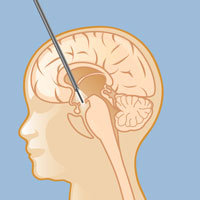As with many other brain tumors, pineal region tumors are best treated with surgery. The surgery, called resection, removes all or part of the tumor — the more tumor that’s removed, the better the prognosis for recovery. These surgical procedures are highly involved and can take several hours. However the surgical management is safe and is no longer associated with the degree of risk that once complicated these types of surgery.
For a benign tumor, surgery may be all that’s needed — complete removal of a benign tumor is often a cure. If the tumor is malignant, the child will probably need surgery to remove as much of the tumor as possible, followed by chemotherapy or radiation to kill off any remaining tumor cells. In some situations, definitive tumor removal would happen after chemotherapy that can shrink the tumor size, thus making complete excision more likely.

Endoscopic third ventriculostomy (ETV) is a minimally invasive procedure that relieves hydrocephalus. This procedure avoids all the inherent risks of implanted shunt devices, which are, however, an option in cases an ETV is not feasible.
Treatment for hydrocephalus is almost always needed for patients with pineal region tumors. Endoscopic third ventriculostomy (ETV) is the preferred method for treating hydrocephalus in these patients since it avoids all the potential risks associated with inserting a permanent shunt device. Frequently the procedure is done simultaneously with endoscopic tumor biopsy using a minimally invasive surgical procedure. If ETV is not possible, then placement of shunt is the alternative.
At Weill Cornell Medicine Neurological Surgery, our pediatric neurosurgeons are highly skilled in the most advanced procedures for treating brain tumors in children. See more about our Children’s Brain Tumor Program.
Reviewed by: Umberto Tosi, MD
Last reviewed/last updated: September 2024